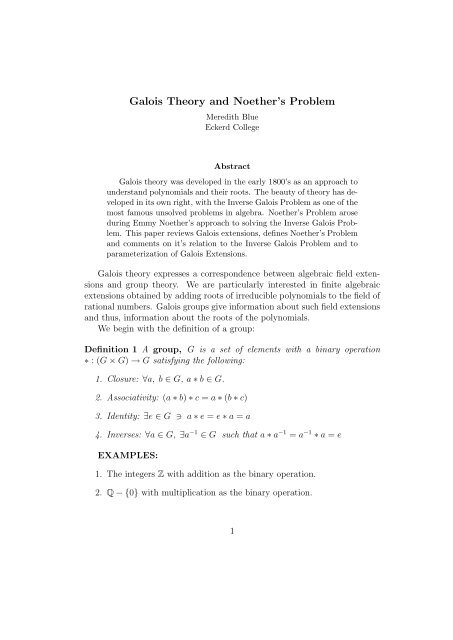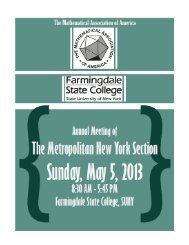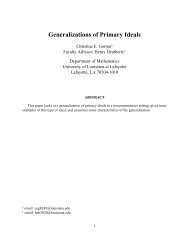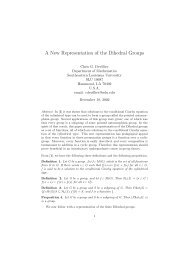Galois Theory and Noether's Problem Meredith Blue ... - MAA Sections
Galois Theory and Noether's Problem Meredith Blue ... - MAA Sections
Galois Theory and Noether's Problem Meredith Blue ... - MAA Sections
Create successful ePaper yourself
Turn your PDF publications into a flip-book with our unique Google optimized e-Paper software.
<strong>Galois</strong> <strong>Theory</strong> <strong>and</strong> Noether’s <strong>Problem</strong><strong>Meredith</strong> <strong>Blue</strong>Eckerd CollegeAbstract<strong>Galois</strong> theory was developed in the early 1800’s as an approach tounderst<strong>and</strong> polynomials <strong>and</strong> their roots. The beauty of theory has developedin its own right, with the Inverse <strong>Galois</strong> <strong>Problem</strong> as one of themost famous unsolved problems in algebra. Noether’s <strong>Problem</strong> aroseduring Emmy Noether’s approach to solving the Inverse <strong>Galois</strong> <strong>Problem</strong>.This paper reviews <strong>Galois</strong> extensions, defines Noether’s <strong>Problem</strong><strong>and</strong> comments on it’s relation to the Inverse <strong>Galois</strong> <strong>Problem</strong> <strong>and</strong> toparameterization of <strong>Galois</strong> Extensions.<strong>Galois</strong> theory expresses a correspondence between algebraic field extensions<strong>and</strong> group theory. We are particularly interested in finite algebraicextensions obtained by adding roots of irreducible polynomials to the field ofrational numbers. <strong>Galois</strong> groups give information about such field extensions<strong>and</strong> thus, information about the roots of the polynomials.We begin with the definition of a group:Definition 1 A group, G is a set of elements with a binary operation∗ : (G × G) → G satisfying the following:1. Closure: ∀a, b ∈ G, a ∗ b ∈ G.2. Associativity: (a ∗ b) ∗ c = a ∗ (b ∗ c)3. Identity: ∃e ∈ G ∋ a ∗ e = e ∗ a = a4. Inverses: ∀a ∈ G, ∃a −1 ∈ G such that a ∗ a −1 = a −1 ∗ a = eEXAMPLES:1. The integers Z with addition as the binary operation.2. Q − {0} with multiplication as the binary operation.1
3. Symmetric Group: Let X be a set with n objects X = {x 1 , . . . , x n }.Let G be the set of all one-to-one onto maps σ : X → X. G is a groupwith binary operation, ◦, composition of functions. This group is calledthe Symmetric Group on n letters denoted S n .4. C = {f : R → R | f is increasing <strong>and</strong> continuous} with binary operationcomposition of functions.If G is a finite group, we let |G| represent the number of elements of G.Next, we define fields:Definition 2 A field F is a set of elements <strong>and</strong> 2 binary operations: + <strong>and</strong>× such that F is a group under + with identity 0, <strong>and</strong> F − {0} is a groupunder multiplication. Moreover:∀x, y ∈ F, x + y = y + x <strong>and</strong> x × y = y × xFor simplicity we write x × y as xy.EXAMPLES:1. Q2. R3. C4. Z 7 = {0, 1, 2, 3, 4, 5, 6} with addition <strong>and</strong> multiplication modulo 7.Definition 3 A field F is a subfield of a field K if F ⊂ K.Definition 4 If f ⊂ K are fields, then we say K is an extension field of F .This is denoted K/F .Let α ∈ C. Let Q(α) be the smallest field containing Q <strong>and</strong> α; in particularany field K that contains Q <strong>and</strong> α contains Q(α). The field Q(α) caneither be an algebraic or a transcendental extension. We give an example ofeach <strong>and</strong> express some important properties of each type of extension.We first consider Q(π). π is transcendental over Q: i.e. there is nopolynomial with rational coefficients that has π as a root. Q(π) is isomorphicto the field of rational functions in x over Q. In addition, we may add anothertranscendental element e. Q(π, e) ∼ = Q(x, y) the field of rational functions2
in 2 variables over Q. These are infinite extensions because Q(x) is infinitedimensional as a vector space over Q. For example, {x i | i ∈ Z} is an infinitelinearly independent set in Q(x) when viewed as a vector space over Q.We next consider Q( √ 2). √ 2 is a root of the polynomial x 2 −2. Thus, wesay √ 2 is algebraic over Q, <strong>and</strong> Q( √ 2) is an algebraic extension field of Q.An easy exercise shows that any element in Q( √ 2) can be written as a+b √ 2with a <strong>and</strong> b rational numbers. Thus, Q( √ 2) is a vector space of dimension2 over Q. This is a finite extension.If an extension field L ⊃ Q can be obtained by adding finitely manyroots of polynomials, we say L is a finite algebraic extension of Q. The nexttheorem states that any finite algebraic extension can be obtained by addinga single element to Q.Theorem 5 (Primitive Element Theorem) Any finite algebraic extension,L, of Q, has the form:L = Q(α) for some α ∈ CLet us return to our original interpretation in terms of polynomials.Definition 6 Let α be algebraic over Q. f(x) is the minimal polynomialfor α (denoted min Q (α)) if:1. f(x) has leading coefficient 1.2. f(α) = 0 <strong>and</strong>3. If g(x) is any polynomial with rational coefficients such that g(α) = 0then the degree of g(x) < the degree of f(x).A polynomial p(x) is irreducible if whenever p(x) = h(x)k(x) with h(x)<strong>and</strong> k(x) polynomials, then either h(x) or k(x) is a constant (i.e. rationalnumber.)Theorem 7 min Q (α) is irreducible.Proof: Let f(x) = min Q (α). Suppose f(x) = p(x)q(x). Since α is a rootof f(x) ∈ C, f(α) = 0 = p(α)q(α). p(α) <strong>and</strong> q(α) are just complex numberswhose product is 0. Thus, either p(α) = 0 or q(α) = 0. Without loss ofgenerality, assume p(α) = 0. Since f(x) is the polynomial with minimumdegree with α as a root, the degree of p(x) = degree f(x). Thus, the degreeof q(x) is 0. This shows f(x) is irreducible.q.e.d.3
Theorem 8 Let f(x) = min Q (α) for some α ∈ C. Suppose g(x) is a polynomialwith rational coefficients such that g(α) = 0. Then, g(x) = f(x)k(x)for some polynomial k(x).Proof: By the definition of min Q (α), deg(g(x)) ≥ deg(f(x)). Using theEuclidean algorithm for polynomials, we can writeg(x) = q(x)f(x) + r(x)where r(x) = 0 or deg(r(x)) < deg(f(x)). Plugging in α for x we haveg(α) = q(α)f(α) + r(α)g(α) = f(α) = 0, so r(α) = 0. Since deg(f(x)) is minimal with respect tohaving α as a root, r(x) = 0. Thus, g(x) = q(x)f(x).q.e.d.<strong>Galois</strong> is famous for his result that polynomials of degree 5 are not solvableby radicals, that is there can be no formula for solving all degree 5polynomials. In light of this we are interested in fields K ⊃ Q where Kis the smallest field containing all roots of a given polynomial with rationalcoefficients. These fields are called splitting fields:Definition 9 A field K ⊃ Q is a splitting field for the polynomial f(x) if1. K contains all roots of f(x).2. If L is another field containing all roots of f(x), then L ⊆ K.<strong>Galois</strong> studied these extension fields using automorphisms:Definition 10 A field automorphism is a mapping φ : F → F where Fis a field satisfying:φ(xy) = φ(x)φ(y)<strong>and</strong>φ(x + y) = φ(x) + φ(y)Let L/Q be a field extension. Let G be the set of automorphisms on Lthat leave Q fixed, that is:σ ∈ G if <strong>and</strong> only if σ : L → L is a field automorphism <strong>and</strong> σ(q) = q forall q ∈ Q.4
Theorem 11 If L/Q is a field extension, then the set, G(G, Q) of automorphismson L leaving Q fixed is a group with binary operation composition ofmappings.Let’s look at this another way. Suppose G is a group of automorphsimson a field F . We are interested in the subset F G ⊂ F that is fixed under allautomorphisms σ ∈ G. An easy exercise shows that this F G is in fact a field.Definition 12 Let G be the set of automorphisms on a field L. The set ofelements x ∈ L such that σ(x) = x for all x ∈ L <strong>and</strong> all σ ∈ G is called thefixed field of G. We denote this L G .Again, we look at some examples to observe that G(L, Q) may be differentfrom G(K, Q) if L <strong>and</strong> K are different extension fields of Q.Example: Consider Q( √ 2). Let G + G(Q( √ 2, Q) be the set of automorphismsof Q( √ 2) that leave Q fixed.There are 2 automorphisms of Q( √ 2) that leave Q fixed, the identity <strong>and</strong>:σ( √ 2) = − √ 2 σ(q) = q ∀ q ∈ QHence, the fixed field of G, Q( √ 2) G = Q.Example: Now consider Q( 3√ 2) ⊂ R. Let H be the set of automorphismsof Q( 3√ 2) that leave Q fixed.Notice that ( 3√ 2) is a root of x 3 − 2. Suppose τ is an automorphism ofQ( 3√ 2). Consider τ( 3√ 2 3 − 2).τ(0) = τ( 3√ 2 3 − 2) = (τ( 3√ 2)) 3 − 2Thus, any automorphism of Q( 3√ 2) leaving Q fixed will take 3√ 2 to anotherroot of x 3 − 2. Since there are no other real roots, all automorphisms in Hmust fix 3√ 2 also.Thus the fixed field of G is Q( 3√ 2).Definition 13 A field extension L/Q is <strong>Galois</strong> with group G if <strong>and</strong> onlyif G is the group of automorphisms of L leaving Q fixed <strong>and</strong> L G = Q.Let us now restate the <strong>Galois</strong> extension condition for the simple algebraicextension L = Q(α) for some α ∈ C. Let f(x) = min Q (α). In this case,L/Q is <strong>Galois</strong> if <strong>and</strong> only if L contains all roots of f(x). This is easily seenin the two examples above. Q( 3√ 2) only contains one root of f(x) = x 3 − 2,whereas Q( √ 2) contains both roots of f(x) = x 2 −2. This is easily describedin terms of splitting fields:5
Theorem 14 A field extension L/F is <strong>Galois</strong> if <strong>and</strong> only if L is the splittingfield for some irreducible polynomial f(x) ∈ F [x].<strong>Galois</strong> theory relates the theory of field extensions to group theory. Inparticular it exhibits a one-to-one correspondence between subgroups of the<strong>Galois</strong> group <strong>and</strong> subfields of the <strong>Galois</strong> field extension. Using this correspondence<strong>and</strong> the theory of solvable groups, <strong>Galois</strong> showed that there canbe no formula to solve all 5th degree polynomials with rational coefficients.The most famous open question involving <strong>Galois</strong> theory is theInverse <strong>Galois</strong> <strong>Problem</strong>: Does every finite group G appear as a <strong>Galois</strong>group over Q?In 1918, Emmy Noether had the following approach to solving the Inverse<strong>Galois</strong> <strong>Problem</strong>:Let G be a finite group. Consider the set of |G| indeterminates indexedby the elements of G:X = {x g | g ∈ G}In particular |X| = |G|. The X is just a set, we want to incorporate thebinary operation of G as well. To do this we consider a group action on X.Definition 15 A group G acts on a set S if there are |G| mappings:satisfyingg : S → S1. e(s) = s for all s ∈ S where e is the identity element of G.2. g(h(s)) = gh(s), where the left side is composition of functions <strong>and</strong> theright side is the mapping given by the element gh ∈ G.In the case of Noether’s approach we let:g(x h ) = x ghNow, form the purely transcendental fieldQ(X) = Q(x e , x g , . . . , x h )We can now think of G as automorphsims of Q(X) by letting g(q) = qfor all q ∈ Q <strong>and</strong> all g ∈ G. We are of course interested in the fixed fieldof Q(X) under G: (Q(X)) G . By construction Q(X)/(Q(X)) G is <strong>Galois</strong> withgroup G.6
<strong>and</strong>σ(x 0 x 1 ) = σ(x 0 )σ(x 1 ) = x 1 x 0 = x 0 x 1It is easy to see that x 0 + x 1 <strong>and</strong> x 0 x 1 are transcendental over Q so thereexists a <strong>Galois</strong> extension with group G over Q. Of course, we saw a concreteexample earlier: Q( √ 2)/Q.Of course, Q( √ 3)/Q is also a <strong>Galois</strong> extension over Q with group G. BothQ( √ 2)/Q <strong>and</strong> Q( √ 3)/Q can be realized as “specializations” of Q(x 0 , x 1 )/Q(x 0 +x 1 , x 0 x 1 ) by using the following map.φ : Q(x 0 , x 1 ) → Q( √ a)is a field isomorphism (i.e. φ(xy) = φ(x)φ(y) <strong>and</strong> φ(x + y) = φ(x) + φ(y))satisfying:φ(q) = q ∀q ∈ Q <strong>and</strong> φ(x 0 ) = √ a <strong>and</strong> φ(x 1 ) = − √ a.In particular φ(x 0 x 1 ) = φ(x 0 )φ(x 1 ) = −a ∈ Q, <strong>and</strong> φ(x 0 + x 1 ) = φ(x 0 ) +φ(x 1 ) = 0 ∈ Q, so Q(x 0 + x 1 , x 0 x 1 ) ∼ = Q. In this specialization a can beany rational number which is not a square. The parameterization can beexpressed by the following sentence: “Any extension of Q with a 2-element<strong>Galois</strong> group is obtained by adding a root of the polynomial x 2 − a where ais any rational number such that √ a is not rational.”References[H] Herstein, I. N. Topics in Algebra. Xerox Corporation. 1975[I][N][S6][Se]Issacs, I. Martin. Abstract Algebra. Brooks/Cole Publishing Company.1994.Noether, E. “Gleichungen mit Vorgeschribener Gruppe.” Math Ann.,78 221-229. (1918)Saltman, David J. “Groups acting on fields, Noether’s <strong>Problem</strong>.”Contemporary Mathematics. Vol. 43 267-277. (1985)Serre, Jean-Peirre. Topics in <strong>Galois</strong> <strong>Theory</strong>. Jones <strong>and</strong> Bartlett Publishers,Inc. 1992.8
[Sw2]Swan, Richard G. “Noether’s <strong>Problem</strong> in <strong>Galois</strong> <strong>Theory</strong>.” in EmmyNoether in Bryn Mawr. Srinivasan, B. <strong>and</strong> Sally, J. eds. Springer-Verlag, New York. 21-40. (1983)9
















